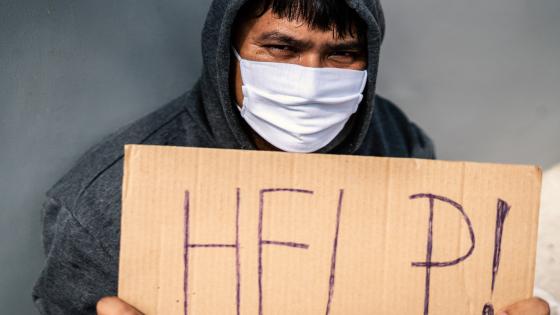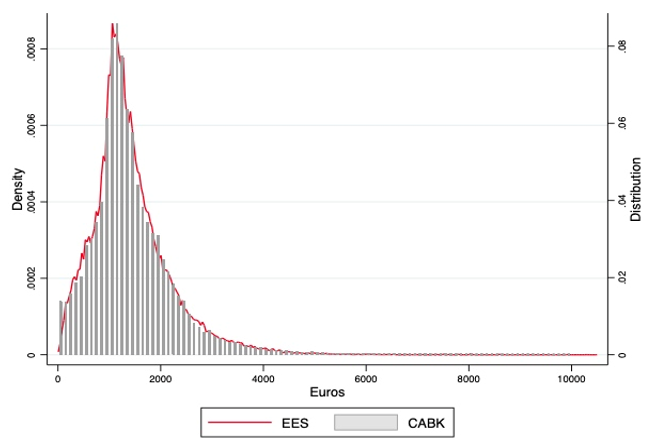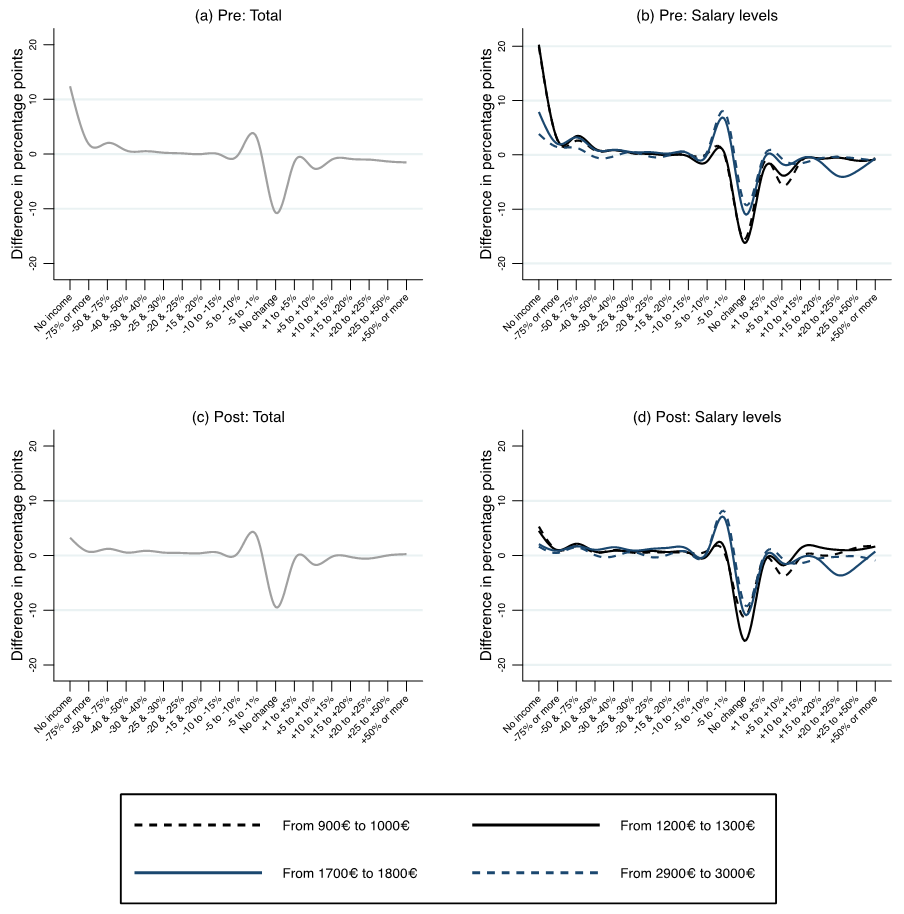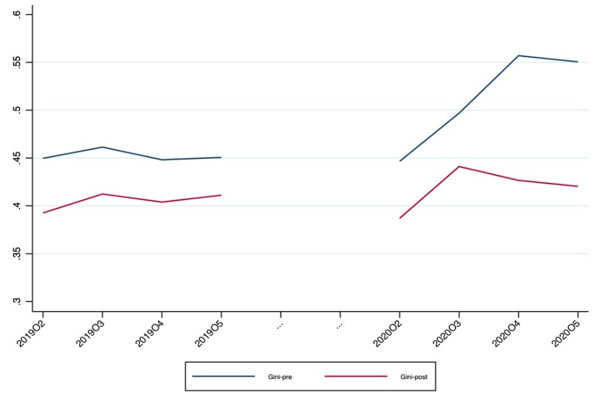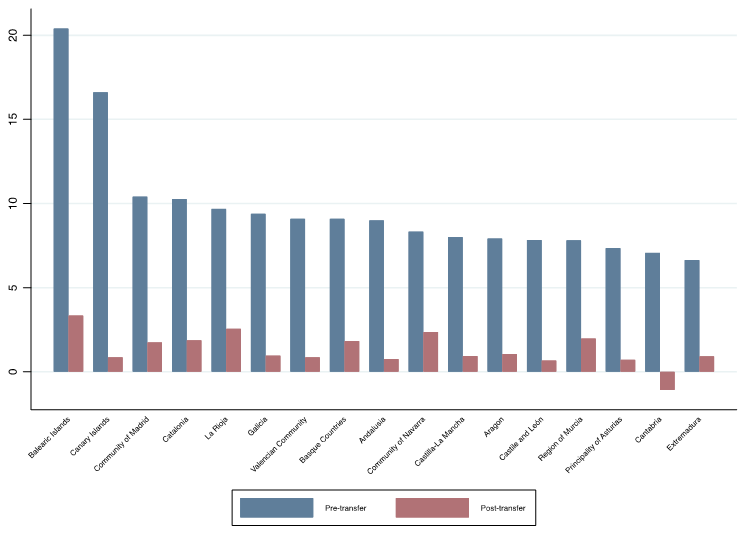COVID-19 has taken a heavy toll on the European economy, particularly in southern countries like Italy and Spain, where GDP is expected to shrink by over 10% in 2020 (IMF 2020a, Bank of Spain 2020). A crucial concern is that the economic impact of the pandemic may disproportionately hit the most vulnerable segments of the population, leading to a surge in economic inequality with potential risks for social cohesion and political stability (Inglehart and Norris 2016). To mitigate the economic consequences of the pandemic, governments are investing vast resources to support families' incomes and provide credit to firms (IMF 2020b, ILO 2020). Yet, how appropriate and effective these policies are remains unclear, mainly due to a lack of reliable indicators allowing the tracking of economic inequality at a high frequency. Indeed, most official statistics on income inequality are available only at a yearly frequency and often with long delays, limiting the ability of policymakers to rapidly adjust their responses.1
In a recent working paper (Aspachs et al. 2020), we propose a new methodology to track the evolution of income inequality at a high frequency using anonymised data from bank records including information on wages and subsidies paid to account holders. Our analysis focuses on Spain and uses data from CaixaBank – Spain’s second-largest bank by total assets and first by direct payroll deposits – which cover over three million retail depositors. Our sample includes all active account holders receiving payroll payments from a private or public employer and/or any government subsidy.2,3,4
The sample is highly representative of the Spanish working population. Figure 1 depicts the distribution of wages in our sample and the distribution of salaries (net of taxes and social security contributions) from the 2014 wave of the Wage Structure Survey (ESS), conducted by the Spanish National Institute of Statistics (INE).5 The similarity between the two distributions is remarkable.
Figure 1 Distribution of wages from bank records and of net salaries from the 2014 Wage Structure Survey
We first examine how wages changed for individuals with different pre-pandemic wage levels following the spread of the virus and the associated lockdown measures (enacted in mid-March). Figure 2 reports the distribution of individuals by the change in wages they experienced between February 2020 and April 2020, that is, between the last full pre-COVID month and the first full post-COVID month. Crucially, to separate the effect of the pandemic from normal wage fluctuations due to seasonality, we net out the difference recorded for people in the same wage level between April and February 2019.6 Hence, moving from left to right on the horizontal axis, we go from people who lost the most to people who gained the most between February and April 2020, relative to 2019. The top panels consider only the wages paid by employers, while the bottom panels consider both wages and government subsidies. The left panels report the distribution for the entire sample, while the right panels depicts the distribution separately for four different wage groups (as of February 2020): (i) people earning between €900 and €1,000 (25th percentile), (ii) between €1,200 and €1,300 (median), (iii) between €1,700 and €1,800 (75th percentile), and (iv) between €2,900 and €3,000 (95th percentile).
Figure 2 Distribution of income changes between February and April 2020 (relative to 2019) by income group
Several clear patterns emerge. First, a much higher share of individuals in the sample lost all of their wages between February and April 2020 than during the same period of 2019. This pattern is more pronounced for people in the lower wage brackets (+20%) than for those in the higher brackets (+8% and +3%). Second, a higher share of people experienced partial wage losses, either large (i.e. -50% to -75%) or small (-1% to -5%), with the latter situation being more frequent among people in the higher wage groups (+8% and +9%). Third, a much lower share of people, particularly in the lower wage groups, experienced wage increases between February and April of 2020 relative to the same period of 2019. Hence, the crisis was detrimental for the vast majority of wage earners but affected lower-income workers disproportionately.
To what extent did government intervention mitigate these dynamics? Looking at the bottom panels, it is clear that public transfers considerably reduced the share of people with no income. This is the case for all groups but especially for those with lower wages. Government intervention also alleviated the situation of those having lost a large part of their income, but not of those having experienced small losses, whose share remains remarkably stable between the pre-transfer and the post-transfer distribution. Finally, public transfers reduced the share of people having foregone wage increases relative to 2019, and, for some groups, even increased the share of those who experienced a moderate or large net increase in wage relative to the previous year.
We then analyse how income inequality evolved over the course of the crisis. To this end, in Figure 3, we plot the Gini index for each month between February and May 2020 (right panel) and for the same months of 2019 (left), for both the pre-transfer (blue line) and the post-transfer distribution (red). While the Gini index in February 2020 was virtually the same as in February 2019 (both pre-transfer and post-transfer), income inequality increased sharply in March, and even more so in April and May when the Gini index was about ten points higher than in February. This represents an unprecedented increase of about 25% in just two months, roughly corresponding to the difference between Germany and the US as of 2016 (World Bank 2020).
Government intervention was quite effective at containing the spike in inequality. Indeed, while the post-transfer Gini index is usually lower than pre-transfer Gini index by about five points, this difference reached 13 points in both April and May 2020, offsetting most, though not all, of the increase in pre-transfer inequality. Government action was somewhat less effective in March, when the post-transfer Gini index reached its peak, about three points higher than in the same month of 2019. This was arguably due to the delay in the disbursement of subsidy and unemployment benefit pay-outs in the early stage of the crisis, which temporarily left some of the most vulnerable workers without a safety net.7
Figure 3 Evolution of the Gini index for pre-transfer and post-transfer incomes (February-May 2019 and 2020)
Finally, we examine how the effect of the crisis on income inequality varied across different areas of the country. To this end, in Figure 4 we report the change in the Gini index between February and April 2020 separately for the sixteen regions of Spain. The results suggest that, though income inequality increased considerably in all regions, the rise was especially strong in regions – such as Balearic and Canary Islands – that rely heavily on tourism, one of the sectors most affected by the pandemic and the lockdown.
Figure 4 Change in the Gini index between February and May 2020 by region
Concluding remarks
Our results document that the COVID-19 pandemic, and the measures adopted to face it, led to a massive increase in income inequality in Spain, primarily driven by job losses and wage cuts for low-income workers. They also indicate that, despite an initial delay, government transfers were effective at containing this increase, reducing inequality to levels not too distant from the pre-pandemic ones. Though reassuring of the ability of the welfare state to cope with such extreme situations, this finding generates some concerns for how things may evolve should the intensity of government intervention decline due to budgetary reasons before the health emergency has ceased. From a methodological perspective, our analysis provides the first example of how banking data can be used to track income inequality at a high frequency. More generally, and in line with other recent experiences (Bick and Blandin 2020, Chetty et al. 2020, Cicala 2020), it illustrates how big data from private sources can be harnessed to better understand the fast changes the economy is undergoing and to inform effective policymaking.
References
Aspachs, O, R Durante, J García Montalvo, A Graziano, J Mestres and M Reynal-Querol (2020), “Real-Time Inequality and the Welfare State in Motion: Evidence from COVID-19 in Spain”, CEPR Discussion Paper n. 15118.
Banco de España (2020), “Escenarios macroeconómicos de referencia para la economía española tras el COVID-19”, Boletín Económico 2/2020.
Bick, A and A Blandin (2020), “Real Time Labor Market Estimates During the 2020 Coronavirus Outbreak”, Working Paper.
Chetty, R, J N Friedman, N Hendren, M Stepner and The Opportunity Insights Team (2020), “How Did COVID-19 and Stabilization Policies Affect Spending and Employment? A New Real-Time Economic Tracker Based on Private Sector Data”, NBER Working Paper n. 27431.
Cicala, S (2020), “Early Economic Impacts of COVID-19 in Europe: A View from the Grid”, University of Chicago Working Paper.
Inglehart, R and P Norris (2016), “Trump, Brexit, and the Rise of Populism: Economic Have-nots and Cultural Backlash”, HKS Faculty Research Working Paper Series RWP16-026.
IMF (2020a), “IMF Data Mapper: GDP growth”.
IMF (2020b), “Policy Responses to COVID-19”.
ILO (2020), “COVID-19 and the World of Work: Country Policy Responses”.
World Bank (2020), “World Development Indicators”.
Endnotes
1 For example, the most recent official measures of inequality available for Spain refer to 2018. A similar lag, when not longer, applies to other countries in and outside the EU.
2 Given the high level of financial inclusion - 97.6% of Spaniards aged 15 or more hold a bank account - bank records provide a very accurate picture of the Spanish working population.
3 We exclude autonomous workers for whom, given the irregularity of earnings, computing monthly income is challenging.
4 That wages represent the main source of income in Spain is demonstrated by the fact that measures of wage and income inequality are very similar. For the last period for which data area available, the Gini index was 34.5 for income and 34.3 for wages. Over the entire period 2008-2016, the average absolute difference between these two indices was just 0.3.
5 The latest wave of the ESS is from 2018. However, individual data are only available for the previous wave, conducted in 2014. To improve comparability between the 2014 ESS data and our 2019-2020 sample, we scale them by the increase in average salary recorded between 2014 and 2018.
6 For a discussion of the challenges involved in the use of high-frequency indicators of economic activity, and specifically of the importance to properly control for seasonal variation, see The Economist’s recent article on “Why real-time economic data need to be treated with caution” (23 July 2020).
7 Preliminary evidence indicates that inequality increased slightly more among women than among men, though the gap disappears once government intervention is taken into account. Large differences emerge, instead, across age groups: inequality increases considerably more among the younger cohorts than among the adults and the elderly, and remains sizeable even after government intervention.
